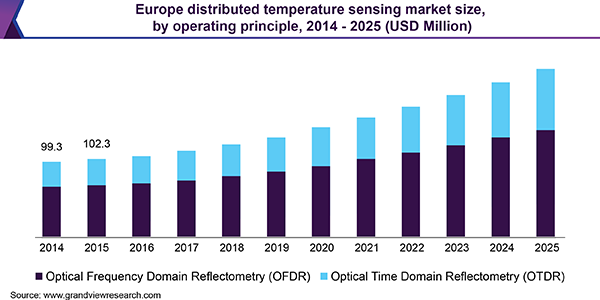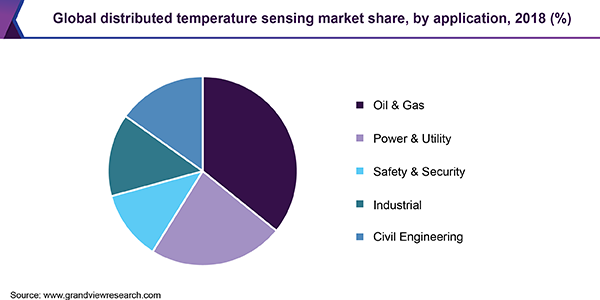According to a report, “Distributed Temperature Sensing Market Size, Share & Trends Analysis Report By Operating Principle (OTDR, OFDR), By Fiber Type (Single-Mode Fiber, Multi-Mode Fiber), By Application, And Segment Forecasts, 2019 – 2025” published by Grand View Research, Inc. The global distributed temperature sensing market size is anticipated to reach USD 849.0 million by 2025, according to a new report by Grand View Research, Inc. It is expected to exhibit a CAGR of 10.7% from 2019 to 2025.
The exponential spread of COVID-19 worldwide has had an adverse impact on the semiconductor industry with manufacturing facilities temporarily shut, leading to a significant slowdown in the production. The outbreak could result in disruption across the ecosystem with several supply chain participants shifting their production facilities outside China, thereby reducing their over-reliance on China. Lockdowns imposed by the governments in the wake of the Covid-19 outbreak has not only affected manufacturing but also hauled consumer demand for semiconductor devices. Our analysts predict a decline in semiconductor revenue by over 1% in 2025 as compared to that in 2019. The report will account for Covid19 as a key market contributor.
In the Distributed Temperature Sensing (DTS) the optical fiber are used as a sensor. The operators can receive information related to temperature after installing such sensors in the fiber cable. The adoption of these sensors has increased rapidly in recent years due to their cost advantages. The DTS uses standard telecoms fiber, thereby requiring no special sensors, and thus saving cost. The cost of material, system design, installation, and maintenance are very low for these sensors, which in turn is projected to positively influence the market growth.
DTS offer fully distributed data, which minimized uncertainties and increased the amount of information received. In addition, these sensors offer very high reliability along with immunity to electromagnetic interference and shock/vibration. Also, distributed temperature sensing can be easily used in space-restricted areas. It also offer other advantages, such as high-temperature performance, long measuring ranges, high-temperature resolutions.
Download Free Sample Report @

The key market participants include Silixa Ltd, AP Sensing GmbH, NKT Photonics A/S, Bandweaver, Sensornet Limited, OFS Fitel, LLC, Schlumberger Limited, Halliburton, OPTROMIX, and Yokogawa Corporation of America. Most companies focus on launching new sensors for temperature sensing. They also focus on launching new products that can help them gain a competitive edge. For instance, in May 2018, AP Sensing GmbH announced the launch of a next-generation distributed temperature sensing. This product will offer various capabilities such as asset monitoring, temperature sensing, and breaking space, time, and accuracy limits.
Further key findings from the report suggest:
- Optical Time Domain Reflectometry (OTDR) is anticipated to continue holding the largest market share over the forecast period, owing to high usage of OTDR as it offers robust measurements
- The multi-mode fiber is projected to hold a high market share in near future. This type of fiber has better ability to launch more power than single-mode fiber, which is expected to drive the growth
- Benefits such as high spatial density and distributed temperature profile provided by a distributed temperature sensing are driving the growth of market
- Asia Pacific is expected to register significant growth over the forecast period, owing to the rising adoption of cost efficient and reliable temperature measuring solutions
- Key market players areSilixa Ltd, AP Sensing GmbH, NKT Photonics A/S, Bandweaver, Sensornet Limited, OFS Fitel, LLC., Schlumberger Limited, Halliburton, OPTROMIX, and Yokogawa Corporation of America
The global distributed temperature sensing market was valued at USD 411.1 million in 2018 and is anticipated to expand at a CAGR of 10.7% from 2019 to 2025. The Distributed Temperature Sensing (DTS) is used for measuring temperature across various fiber optic applications using optical fibers. Various advantages of DTS include compact size, resistance to ionizing radiation, and immunity to electromagnetic interference. These advantages have propelled their usage for sensing and measuring temperature across various applications, such as oil and gas, power and utility, and others.
Distributed temperature sensing is an emerging technology; therefore, its implementation across water-based applications has increased in recent years. A wide range of geophysical methods are being designed for monitoring hydrologic processes at large scales and the catchment. The demand for some geophysical methods is on the rise, in order to quantify the fluxes between the surface water and groundwater. All these factors are anticipated to contribute to the rising adoption of DTS.
The DTS using fiber optic cable is carried by sending a laser light along the fiber-optic cable. The photons in the light interact with the molecular structures of fiber and the incident light scatters. The variation observed in the optical powers is used for measuring the temperature. In hydrologic processes, the distribution temperature sensing is used across various applications, such as in characterizing the interaction of a stream and an estuary in the aquifer and determines transmissive fractures in bedrock boreholes.
Have some specific queries about this report, our team of analyst will be glad to help!
The use of distributed temperature sensing for monitoring of temperature patterns in the stream bed in order to determine various zones where groundwater is discharged is also on the rise. Distributed temperature sensing also enables monitoring of downhole temperature in order to study hydrogeological processes at spatial resolution and high frequency. Implementation of these sensors in passive mode for in site investigation of in-well flow, groundwater flow, or for the estimation of subsurface thermal property is also on the rise. Such factors are substantially propelling the use of distributed temperature sensors thereby driving market growth.

Based on measuring principle, the distributed temperature sensing market is categorized into Optical Time-Domain Reflectometry (OTDR) and Optical Frequency-Domain Reflectometry (OFDR). The former principle is widely used for measuring the losses in telecom sector. In the OTDR principle, a laser pulse is generated from solid-state or semiconductor lasers, and is sent into the fiber. The backscattered light is analyzed for temperature monitoring. Most distributed temperature sensing systems are based on optical time domain reflectometry operating principle, thereby holding a high market share.
Grand View Research has segmented the global distributed temperature sensing market based on operating principle, fiber type, application:
Distributed Temperature Sensing Operating Principle Outlook (Revenue, USD Million, 2014 – 2025)
- Optical Time Domain Reflectometry (OTDR)
- Optical Frequency Domain Reflectometry (OFDR)
Distributed Temperature Sensing Fiber Type Outlook (Revenue, USD Million, 2014 – 2025)
- Single-Mode Fiber
- Multi-Mode Fiber
Distributed Temperature Sensing Application Outlook (Revenue, USD Million, 2014 – 2025)
- Oil and Gas
- Power and Utility
- Safety and Security
- Industrial
- Civil Engineering
About Grand View Research
Grand View Research, Inc. is a U.S. based market research and consulting company, registered in the State of California and headquartered in San Francisco. The company provides syndicated research reports, customized research reports, and consulting services. To help clients make informed business decisions, we offer market intelligence studies ensuring relevant and fact-based research across a range of industries, from technology to chemicals, materials and healthcare.
Media Contact
Company Name: Grand View Research, Inc.
Contact Person: Sherry James, Corporate Sales Specialist – U.S.A.
Email: Send Email
Phone: 1-415-349-0058, Toll Free: 1-888-202-9519
Address:201, Spear Street, 1100
City: San Francisco
State: California
Country: United States
Website: https://www.grandviewresearch.com/industry-analysis/distributed-temperature-sensing-market

